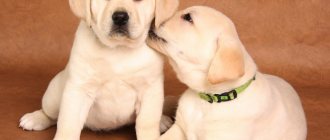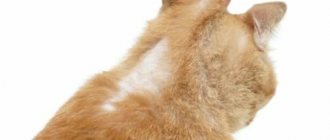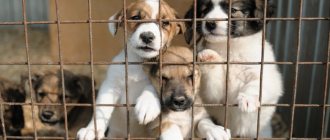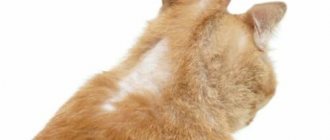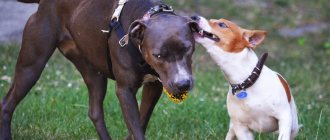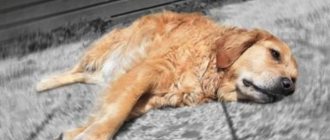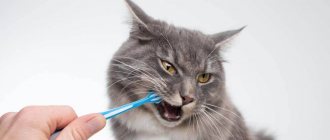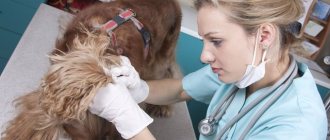The word lichen is used in everyday life when bald spots appear on an animal. However, this name hides diseases with different pathogens, external symptoms and treatment methods. They are not classified as complex or incurable, and only one is transmitted to humans. In this article, we will look at what lichen in a dog looks like in a photo, signs and treatment of skin lesions of various origins.
- What does pityriasis rosea look like?
- Initial signs of pityriasis versicolor.
- Signs of weeping lichen in the initial stage.
How can a dog get shingles?
Ringworm in dogs is fungal and viral in nature. A four-legged friend can “catch” the disease in several ways:
- through direct contact with a sick animal;
- through household items (bowl, leash, collar, comb, etc.) belonging to an infected dog;
- through soil, grass and so on.
The likelihood of developing lichen increases significantly if the animal has reduced immunity. This condition may be caused by the dog’s pregnancy or lactation, a recent infectious disease, or a poor diet. The protective forces are also reduced if the pet has been taking corticosteroids for a long time, as well as if he has a malignant tumor.
Stray animals and those living in poor conditions constitute a special risk group. Dampness, lack of hygiene, high density (for example, in shelters) and other factors provoke the rapid spread of fungus.
Note: dogs with long and thick hair require special attention from owners. Due to the nature of their hair, their skin is poorly ventilated, which makes such pets the most vulnerable to infection.
Types of fungal infections
Pathogens: trichophytosis fungi, microsporia, reservoirs: cats, rodents, soil. They are transmitted through scales, wool, care items, wherever spores are located. Pets and people can get sick when in contact with carriers of the fungus.
Who can become infected:
- dogs with low immunity;
- patients with viral infection;
- animals on a poor diet;
- with oncology;
- when taking drugs that suppress the immune system;
- pregnant, lactating bitches.
The intensity of the signs depends on the strength of the immune system, the presence of chronic diseases, and the age of the animal.
What does canine ringworm look like?
Mycotic lesions have the appearance of bald spots, localized round baldness with scales and crusts. Favorite places for microsporia are the muzzle, nose, ears and front paws.
The mistake of most owners is to consider any areas of alopecia as lichen. Problems with hair and skin occur due to improper nutrition and mechanical damage. Only in a veterinary clinic will a correct diagnosis be made and treatment prescribed.
Symptoms at the onset of the disease
What symptoms of ringworm in dogs should you pay attention to first? The latent period of the disease, on average, lasts about 10-14 days, depending on the type of lichen. Only after this do signs of the disease become noticeable.
At the initial stage of deprivation, the owner will notice the following manifestations:
- the animal scratches the same place;
- in the area of itching, superficial skin damage is noticeable in the form of discoloration, broken hairs, cracks, peeling and others;
- gradually the spot increases, new lesions appear;
- the dog becomes lethargic.
In most cases, skin lesions occur on the pet's paws, lower abdomen, and face.
Action must be taken quickly, as the disease is spreading at high speed. In addition, reduced immunity and damaged skin surface favor the addition of a bacterial infection and the development of other diseases.
Characteristic symptoms of trichophytosis
It is difficult to determine microsporia on your own. Its signs look like this:
- foci of alopecia with smooth edges, the dermis inside is lumpy, with inflammation;
- localization on the periphery (paws, head, tail, ears);
- severe peeling;
- lesions with redness are very different from healthy skin;
- pain, scratching, itching.
You cannot cut off alopecia, use ointments, iodine, brilliant green, folk remedies, or creams. Any manipulations with foci of fungal infections will lead to infection, spread of fungal spores and blur the clinical picture, making diagnosis difficult.
Photos of lichen in dogs
Types of lichen in dogs
Several types of lichen are diagnosed in dogs, each of which has its own nature, symptoms and treatment approaches. That is why veterinarians insist that if they discover suspicious spots on their pet’s skin, the owners should immediately contact the clinic. At the same time, every owner should know what this or that type of disease looks like. This will allow you to quickly take preventive measures for household members (some fungi can be transmitted to humans) and for the animal (to stop further spread).
Pityriasis rosea
Pityriasis rosea is an allergic reaction to an infection, presumably of a viral nature. Most experts associate the development of this type of disease in domestic dogs with a genetic predisposition. Skin lesions, as a rule, occur against the background of viral diseases of the digestive tract, respiratory system, and after vaccinations.
Pityriasis rosea in dogs
Pityriasis rosea is characterized by a chronic course, so it is not possible to completely cure the animal. The disease occurs every time the pet’s immune system activity decreases: under stress, poor diet, and frequent illness. At the same time, the dog is not a source of danger to other animals and humans. However, if they have the same predisposition and low immunity, the likelihood of infection - even if it is miniscule - exists.
How to recognize pityriasis rosea in a domestic dog? This type is characterized by the following clinical picture:
- spots do not exceed 2 cm;
- the affected areas have a pink tint with a yellowish center;
- the bulk of the rashes are localized in the groin, on the face;
- the lesions are gradually destroyed with the formation of yellow areas with peeling of the epidermis.
Attention: pityriasis rosea can be complicated by the penetration of fungi, bacteria, and viruses into the skin, so treatment should not be delayed.
Ringworm
Ringworm on a dog's face
Ringworm is the dog’s body’s immune response to an allergen; eczema, which is not based on an infectious nature. An allergen can be any substance (medicine, food, etc.), hormonal disorders. The disease is chronic and manifests itself with the following clinical picture:
- swelling appears on the surface of the skin, hot to the touch, itchy and painful;
- bubbles gradually form in their place;
- baldness occurs in the affected area;
- discharge from the blisters gradually becomes purulent;
- The most common localization is the cheeks, tailbone, and neck.
As the skin heals, it becomes crusty, revealing healthy tissue underneath.
Since tinea versicolor brings significant pain to the dog in the form of itching, it begins to scratch the skin vigorously. This can cause an increase in the area of the affected areas and the addition of infection.
Ringworm
Ringworm in a dog
Unlike previous types, ringworm (clipped) is a fungal disease. Its development is caused by the penetration of fungi of the genus Microsporum or Trichophyton into the skin, causing, respectively, microsporosis or trichophytosis. Ringworm is a dangerous and contagious disease that can be identified by the following signs:
- small skin lesions (about 20 mm);
- color of spots – from pinkish to brown;
- their outline is clearly visible;
- localization – base of the tail, limbs;
- severe itching;
- baldness of the affected areas.
The infection is characterized by a rapid rate of spread. If no action is taken, the fungus can lead to the death of the dog in a short period of time.
Pityriasis versicolor
Pityriasis versicolor in a dog
This type of disease is caused by a yeast fungus of the genus Malassezia, which normally lives on the surface of the skin of not only dogs, but also other animals and people. In the absence of damage to the epidermis and strong immunity, the microorganism does not show aggression. Otherwise, the fungus multiplies vigorously, releasing large quantities of caustic acid, which literally “corrodes” the epidermis.
Another name for lichen is multicolored. This is due to the different shades of the lesions: pinkish, brown, brownish. Another sign is baldness in the affected areas. Since the spots quickly enlarge and merge, the disease can spread throughout the dog’s entire body in a short time.
Symptoms and where they appear
To ensure that your pet’s treatment does not drag on for many months, you should contact a veterinarian at the first symptoms of the disease.
The first signs are usually subtle for both the owner and the dog. They can only be seen in areas with sparse short hair and thin skin (muzzle, ears, belly), in these places the skin turns red and becomes rougher.
Over time, the signs become more noticeable. In the affected areas, the hair breaks off and falls out. This may happen in one day or gradually. In some cases, outwardly it seems that the wool is in place, but if you pull it slightly, the whole clump will remain in your hands.
In the future, there are more and more hairless areas, they can be of different sizes and shapes. They occur on absolutely any part of the body.
In the deep form, skin lesions are more serious. Purulent inflammation develops, ulcers and crusts with dried exudate (pus) can form. When they are removed, an ulcerated, painful surface is exposed. Various manifestations of such symptoms are given the names shingles, weeping, etc.
In some cases, the fungus affects only the claws, this is called onychomycosis. The treatment is quite lengthy and in severe cases, amputation of the claw phalanx may be necessary.
Dogs, when infected with a fungus, necessarily show clinical signs, unlike cats (they are asymptomatic carriers of a fungal infection), with the exception of the Yorkshire Terrier breed.
Diagnostics
Before treating a dog for lichen, it is necessary to diagnose the identified pathology and differentiate it from other skin diseases. Ringworm in dogs can be confused with diseases such as dermatosis, pyoderma, seborrheic eczema, pityriasis versicolor and pityriasis rosea.
The following methods are used for diagnosis:
- illumination with a Wood's lamp;
- wool analysis (seeding);
- skin biopsy.
Microscopic examination reveals the presence/absence of spores and mycelium; culture makes it possible to determine the type of fungus. In addition, laboratory tests of the pet’s urine and blood are required. Additionally, the doctor may prescribe allergy tests and tests.
What can you do to speed up your recovery?
How to cure a dog from lichen without causing complications? The main condition is strict adherence to the recommendations of the veterinarian. The animal must be given medications in strict accordance with the prescribed course and dosage, without skipping doses. Unauthorized replacement of one medicine with another, as well as termination of therapy prematurely, is not allowed. The dog owner should be prepared for the fact that in some cases treatment may take a month or more.
Treatment with special shampoos that contain antifungal components will help speed up the recovery of your four-legged friend and prevent the spread of infection. Such hair care products are gentle on the surface of the skin, but using them for a long time is not recommended. To avoid excessive dryness of the epidermis, follow the instructions.
Dog Owner Stories
Valeria: “My shepherd dog developed some kind of black crust on his nose, then the hair in this area began to fall out. The vet diagnosed it as ringworm. We were prescribed Imaverol. They told me to treat the affected area of the nose once every 3-4 days for 2 months. They also prescribed Clotrimazole ointment to smear my nose with. Additionally, they advised to give the dog vitamins. After the first treatment with Imaverol, the dog’s nose turned red and there was ichor in some places. It scared us. But, after 3 days everything began to dry out, and a week later new hairs of fur began to appear on the nose. We managed to completely get rid of lichen in 1.5 months.”
Sergey: “My Yorkie got shingles after the show. We received 2 Microderm injections. One was done immediately at the appointment, the second was done 10 days later. During breaks, I treated the affected areas with Yam ointment. We got rid of this infection quite quickly. During the treatment period, we went with the dog to live in the country so as not to infect the children and the cat.”
Marina: “I always thought that only cats have lichen. Therefore, I didn’t pay much attention when my dog’s hair began to fall out around his eye and redness appeared. The first days I lubricated this area with iodine. It seemed to me that this would be right. But when, after a week, the spot began to increase in size, and the dog began to try to scratch the eye, I got scared. My husband and I took her to the vet. Only there I found out that it was lichen. The doctor immediately prescribed Itraconazole tablets and forbade me to smear the area with iodine. Instead of iodine, he advised treating the wound with Fukortsin. We were treated for almost 2 months. If I had known earlier how dogs get lichen, we would have cured the dog faster.”
How to prevent your dog from licking ointment and scratching
Foci of lichen cause severe itching in the pet. When he scratches the affected area, the infection spreads to adjacent healthy tissue, which significantly delays recovery. The same thing happens if the animal licks the applied ointment.
If the lesions are single, you can seal them with a plaster or bandage them, after applying a gauze swab with ointment to the affected area. It is possible to prevent scratching of large areas using a special collar. If the dog resists such a device and removes it, you should put a jumpsuit on it.
Characteristic
Ringworm (dermatomycosis) is a contagious disease.
The causative agent is an infectious and bacterial fungus. Its spores are resistant to environmental conditions. Their viability lasts for years. It reproduces intensively in wet weather. The fungus affects the skin of animals and people. The disease manifests itself as a rash on the skin. Accompanied by severe itching. Can affect any part of the body. Without treatment, the infection covers the entire surface of the animal's body. The skin becomes covered with reddish crusts and hair falls out. Bald spots with clear boundaries appear. Infected lesions may ooze pus.
An infected animal appears sick. Loses activity, becomes lethargic, or becomes restless. Immunity decreases. The pet becomes vulnerable to other diseases.
Take the Attention Test! Find 10 differences! (click right here!)
Find the answer Are you bothered by some problem or question? Enter “Breed” or “Name of the problem” into the form, press Enter and you will find out everything about the issue that interests you.
Types of lichen:
- Pink;
- Shearer;
- Weeping;
- Pityriasis;
- Encircling.
With pityriasis rosea, a spot appears - a maternal plaque. It causes other spots to form. The spots are round in shape and small in size. The dog begins to comb them. The color of the affected lesions is yellow-pinkish. Hence the name of the disease.
Ringworm appears as a spot with a clear outline, 2 cm in diameter. Hair falls out on the affected area. The spot begins to peel and itch. The infection can quickly spread throughout the body. The type of disease is contagious to others.
Ringworm occurs as an allergic reaction and is inflammatory in nature. The affected area cracks and begins to get wet. A crust forms.
The pityriasis type of the disease forms in different areas of the skin. It first appears as a small pink spot. Then it grows, the color becomes yellow or brown.
The causative agent of shingles is the herpes virus. Appears in the form of papules with liquid. The liquid contents come out and dry out. The infection is localized in the abdomen. The pet begins to scratch its belly. The disease then affects other places.
Take action at the first sign of illness. Isolate your dog from people and other animals. The pet must be kept separately until recovery. Disinfect the place where the dog lived.
Can iodine be used to treat ringworm?
The use of iodine to treat ringworm in dogs depends on the pathogen identified. So, with the ringworm type of the disease, this drug has the most effective effect. It is not recommended to use iodine solution for pityriasis rosea. In other cases, the remedy does not lead to any pronounced result. It should be noted that some veterinarians are categorically against the use of iodine for lichen. Judging by the reviews, you should not try to cure an unusual “spot” on your own using iodine as a panacea - this can lead to disastrous consequences for the dog.
Pityriasis rosea
Pityriasis rosea is considered the safest disease, and it is not transmitted from animals to humans. It's quite easy to notice. Pink spots appear on the pet's body, which can reach 3 centimeters in diameter. These spots constantly itch and flake. This causes quite a lot of discomfort for the dog. After some time, these spots become covered with a crust, which is quite easy to peel off. Next to a large spot, other, smaller ones may appear, but they will itch with the same force.
Most often, pityriasis rosea appears due to the fact that the dog's immunity is reduced. That is why this disease is more often diagnosed in puppies, as well as in weakened or elderly dogs. Until now, scientists cannot say for sure what is the causative agent of this disease. However, there are suggestions that it is a herpes virus.
It is worth noting that this is the only type of lichen that can disappear without any treatment. However, this will take time - 2-3 months. But this does not mean that the owner can calmly expect that everything will go away on its own. It is better to contact a specialist who will give the necessary recommendations for caring for a sick dog. The owner should pay special attention to feeding the dog, as well as its hygiene. The dog may be prescribed a vitamin complex to boost its immunity.
Nutrition for dogs during the treatment of lichen
Treatment of lichen in dogs must necessarily be accompanied by a change in diet. This is especially true for pink and weeping types of the disease, which are allergic in nature. A special diet is designed to minimize the toxicity and allergenicity of certain foods and substances. The following should be excluded from the diet:
- potato;
- chocolate;
- sweets;
- smoked meats;
- spices;
- any products containing dyes, flavors, preservatives and other additives.
In case of weeping lichen, you will need to remove meat and meat products from your pet’s menu for a while.
How to apply ointment correctly
The better prepared the affected area of a dog's skin for lichen, the greater the effect that can be achieved from the medicinal ointment, so every owner should know the algorithm of actions when treating an infectious source.
- Prepare the following items in advance: medical rubber gloves, blunt-tipped scissors, a metal container and matches, soap solution, antiseptic (furacilin, chlorhexidine, hydrogen peroxide), tweezers, gauze wipes, medicinal ointment.
- Before proceeding directly to the procedure, put on gloves.
- The affected area of skin is treated with an antiseptic solution.
- If there is hair along the periphery of the lesion, the hair is carefully cut at a distance of approximately 5 mm from the affected epidermis. The cut hair is immediately burned.
- If there are scabs, soak them in a soap solution until completely softened.
- The scabs are removed with tweezers, and the area is again treated with an antiseptic.
- Use a napkin to remove any remaining moisture.
- Apply ointment.
Upon completion of treatment of all affected areas, the clipped wool and napkins should be burned.
Professional treatment
The disease requires an integrated approach to treatment. The full course lasts from 6 to 8 weeks. This is due to the high survivability of fungal spores. It is impossible to completely cure a dog if you use only local treatment of the affected areas. To increase efficiency, treatment measures are carried out simultaneously with disinfection of the animal’s habitat and care items.
initial stage
While the area of the affected areas of the dog’s skin is not very large, it is enough to treat the affected areas with external antifungal and anti-inflammatory agents:
- creams;
- emulsions;
- ointments;
- sprays;
- shampoos.
Read more about popular external medications further in our article.
Severe (advanced) stage
In case of a large degree of damage and an advanced form of the pathology, it is necessary to give oral medications simultaneously with the treatment of diseased areas of the skin.
The most effective are:
- griseofulvin;
- ketoconazole;
- fluconazole;
- terbinafine;
- intraconazole
All these drugs are also used to treat humans. The veterinarian must select the product and calculate the permissible dosage.
Important!
Simultaneously with the treatment procedures, everything that the sick dog has come into contact with is disinfected.
External preparations – solutions, ointments, sprays
Ointment Yam Bk
A popular external fungicidal-bactericidal agent that has no analogues. It is highly effective against fungal diseases. It has been used in veterinary medicine for a long time. The product is low-toxic and safe for animals of all ages and conditions.
Contains: tar, salicylic acid, sulfur, turpentine, petroleum jelly, zinc oxide, creolin, lanolin.
How to use: apply a thin layer to the affected areas and around them (3-4 cm) with a special spatula 2-3 times a day for 7-10 days.
What it treats: ringworm, shingles.
Price: 20 mg pack. – 75 rub./18 UAH.
Fungin
A dermatological agent with an antifungal effect is available in the form of sprays and solutions. The main active ingredient is clotrimazole. The drug relieves the animal from itching and effectively destroys pathogenic cells. Has wound healing properties.
Contains: sulfur, glycerin, propolis.
How to use: the product is applied to and around the affected areas using a cotton swab or sterile gauze and gently rubbed into the skin. The procedure is repeated once a day for 10-14 days.
What it treats: ringworm, pityriasis versicolor.
Price: solution (30 ml.) – 310 rub./85 UAH; spray (30 ml.) – 415 RUR/115 UAH.
Clotrimazole
The antifungal agent is based on synthetic imidazole. The active component suppresses the proliferation of the fungus and causes its death.
How to use: Apply a thin layer of ointment to the affected areas of the skin, covering the area around them. The procedure is repeated 3-4 times a day for 3-4 weeks.
What it treats: pityriasis versicolor.
Price: tube (20 g.) – 185 rub./31 UAH.
Sanoderm
Complex action cream based on betamethasone, gentamicin and clotrimazole. It has antibacterial, anti-inflammatory and anti-allergenic effects. Effective against fungi.
How to use: apply a thin layer to affected areas 2 times a day for 2-4 weeks.
What it treats: ringworm.
Price: tube (15 g.) – 110 rub./55 UAH.
Fukortsin
The solution, popularly called “red brilliant green,” has an antiseptic and disinfectant effect. Contains: boric acid, phenol, acetone and resorcinol. The product is toxic and should not be licked off.
How to use: the affected areas are lubricated with the solution 3 times a day until complete healing.
What it treats: shingles, ringworm.
Price: bottle (25 ml.) – 40 rub./10 UAH.
Imaverol
An effective antifungal emulsion based on enilconazole. The active substance destroys fungal spores at the cellular level. Used in complex therapy. The product is safe, acts in the superficial layers of the skin, and is quickly removed.
How to use: before use, dilute the emulsion with boiled water at room temperature (1:50). The affected areas of the skin are treated with a cotton pad once every 4 days.
What it treats: ringworm.
Price: bottle (100 ml.) – 1450 rub./845 UAH.
Oral medications – capsules, tablets
Griseofulvin
Antifungal antibiotic based on the substance Griseofulvin. Has a cumulative effect. The active ingredient of the drug stops the proliferation of the fungus.
How to use: Give dogs 1 tablet 4 times a day during feeding. The course of treatment is 14-20 days.
What it treats: ringworm.
Price: pack (20 tablets) – 220 rub./45 UAH.
Ketoconazole
Tablets with antifungal, fungistatic and antiandrogenic effects. The drug is considered potent.
How to use: give to animals with food at a dosage of 5-10 mg/kg every 10-12 hours or once a day at a rate of 10-20 mg/kg.
What it treats: ringworm, weeping lichen.
Price: packaging (10 tablets) – 150 rub./130 UAH.
Fluconazole
A synthetic antifungal agent inhibits the activity of fungi. It is excreted unchanged through the dog's kidneys.
How to use: give to animals along with food at a dosage of 10-20 mg/kg 2 times a day.
What it treats: ringworm, weeping, pityriasis versicolor.
Price: packaging (10 tablets) – 35 rub./12 UAH.
Terbinafine
Tablets with pronounced antimycotic and anti-inflammatory effects are prescribed as part of complex therapy. Shows activity against pathogens of dermatomycosis.
How to use: give to animals with food once a day at a dosage of 20-30 mg/kg.
What it treats: pityriasis versicolor (lichen versicolor).
Price: pack (10 tablets) – 140 rub./45 UAH.
Intraconazole
The most effective medicine in the treatment of ringworm. Itraconazole suppresses the proliferation of the fungus and prevents it from developing. Available in capsule form.
How to use: give to animals with food once a day at a dosage of 10 mg/kg. The course of treatment is up to 1 month.
What it treats: ringworm.
Price: pack (14 drops) – 320 rub./43 UAH.
Therapeutic vaccines
The most effective in the treatment of lichen are therapeutic and prophylactic vaccines. For medicinal purposes, injections are given 2-3 times with an interval of 10-14 days.
The following drugs are used to vaccinate dogs:
- Polivac TM;
- Vakderm-F;
- Microderm.
How to know if treatment is helping
Signs indicating that therapy is effective:
- In the affected areas, crusts are actively separated.
- New fur begins to grow on the bald patches.
- Skin redness disappears.
- The itching goes away and the dog itches less.
It is possible to finally ensure that the treatment has achieved its goal only in a clinical setting. There, the dog is examined under a Wood's lamp and scrapings and cultures are taken. Only after two negative tests performed at monthly intervals can we talk about the dog’s complete healing.
Can humans or pets become infected?
Every dog owner should know what type of lichen is transmitted to humans and other animals. Regarding ringworm, the answer is clear - this disease is highly contagious and very contagious. When diagnosing it, the animal must be isolated from other pets and household members (especially children).
Ringworm does not pose a danger to others, as it is eczema of allergic origin. Regular hygiene measures when caring for a sick pet are quite sufficient.
The possibility of transmission of infection with pityriasis rosea is currently questionable. The opinions of experts of different specializations contradict each other: some believe that this disease is contagious, others say the opposite. In general, it is generally accepted that if a person has a strong immune system, then pityriasis rosea is not dangerous for him. If the immune system fails (due to age, illness and other reasons), then it is best to stay away from the animal.
Pityriasis versicolor also does not pose a danger to humans and animals, since the fungus is also present on the surface of their bodies. There is a theoretical probability that household members will develop the disease if their immunity is greatly reduced, so if your apartment contains a dog with pityriasis versicolor, it is better to play it safe and isolate it from children, the elderly or weakened people.
What should you be afraid of?
There are three types of lichen, each of which is dangerous for humans in different ways. Geophilic develops upon contact with soil contaminated with fungal spores. Zooanthropophilic - contagious to people and animals; with the anthropophilic type, only humans are sick.
Ringworm and shingles can infect humans. Red flat, pityriasis, weeping, scaly are harmless forms. Eczema and psoriasis are lichen-like formations that act as opportunistic diseases.
Is there a vaccine against ringworm in dogs?
You can prevent the development of lichen in a dog by administering a special vaccine. The drugs Vakderm and Mentavak have good reviews. These are intramuscular injections that contain inactive fungi that cause lichen. Vaccines can be given after examining your four-legged friend, deworming, and examination by a veterinarian. Vaccines can also be used if the animal is already suffering from shingles. Self-administration of injections is not recommended, since the dosage and course require an individual approach.
Prevention of lichen in dogs
You can prevent the development of lichen in dogs by following a number of preventive measures:
- protect your pet from contact with unfamiliar and homeless animals;
- observe sanitary and hygienic standards, wash the dog in a timely manner with suitable products (including preventative ones);
- feed your pet correctly, avoiding the presence of possible allergens in the food;
- ensure that the animal’s diet is complete;
- get vaccinated in a timely manner;
- do not limit your pet on walks;
- avoid using extraneous bowls, collars and other household items;
- Treat identified diseases in a timely manner, avoiding a strong decrease in immunity.
Every year, microbes undergo mutations and become more and more resistant to the drugs used, so a single and 100% effective treatment regimen for lichen in dogs has not been developed. In addition, each animal reacts differently to the medicine and the causative agent of the disease, which also affects the speed and effectiveness of therapy.
However, shingles in dogs can be cured. To do this, you need to quickly respond to the symptoms, bring your pet to the clinic, follow the specialist’s recommendations and continue to follow preventive measures.
Main signs of the disease
How to identify ringworm in a dog ? In order not to miss the onset of the disease and to notice the first signs of lichen in their pet in time, owners need to be as careful as possible when examining the animal’s body, especially for long-haired pets. Remember that first of all, lichen lesions will appear on the dog’s face, paws and stomach. And if you notice any, even small, areas where there is a noticeable change in the coat - broken hairs, baldness of the coat, hair loss - this is a sign to show your pet to the specialists of the veterinary clinic, who will take a culture or check the hairs under a microscope. The sooner lichen is detected in a dog, the faster and easier its treatment will be. And if your beloved pet scratches its skin in the same place, its skin peels off or it has changed color, the animal’s behavior has changed: it has become apathetic, refuses to eat, or its food preferences have changed greatly, an elevated temperature - these are signs that that the dog has shingles.
As you already understand, every day animals encounter such a disease as lichen in the environment, but not everyone gets sick with it. Of course, the main role in this process is played by the state of cell-mediated immunity, which is involved in the protective mechanism against infectious diseases. Also, the likelihood of disease is very actively and directly affected by:
- state of local skin immunity, skin damage, constant hydration of the skin;
- the presence of other chronic diseases of the skin, digestive system, metabolic and hormonal disorders;
- cancer, chemotherapy, use of anti-inflammatory drugs and immunosuppressants;
- viral and bacterial infections;
- age – puppies are more susceptible to fungal infections due to an imperfect immune response;
- pregnancy and lactation in females;
- improper feeding, hygienic care and maintenance of the animal;
- constant stress - remember, animals, like people, can endure one-time stress, but chronic stress will definitely turn into illness;
- The owner of a dog can also become a source of infection for his four-legged pet;
- Insects, most often mites, are also very often active spreaders of fungi that lead to this disease.
When an infection occurs, fungal spores first land on the dog’s skin and fur, then germinate and invade the hair follicles. The hair itself is destroyed, but its growth does not stop. At the site of the fungal infection, local inflammation of the skin develops, the hair becomes brittle, dry and loses its shine.
There are two forms of the disease – classic and latent. In the classic course of lichen, a superficial skin lesion appears, with limited areas of baldness with peeling and signs of inflammation, the hair in this area is sparse, short, and broken. With a high degree of infection, large areas of baldness appear. In the latent form of lichen, there are no clinical symptoms or they are nonspecific - in the form of small isolated baldness and skin lesions.
With a long course of the disease, inflammation spreads quite deeply, affecting the dermis and subcutaneous tissue. In this case, weeping areas of skin with crusts and damage to the hair follicles are formed, as well as the appearance of inflammatory foci in the subcutaneous tissue, after healing of which a scar remains on the skin. This may also be accompanied by damage to the fingers and claws with the development of dystrophic processes. A severe form of lichen is often complicated by a bacterial infection and can occur in combination with demodicosis, especially in young animals with poorly formed immunity.
